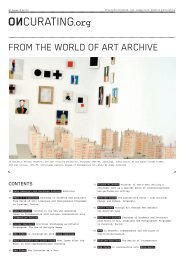Create successful ePaper yourself
Turn your PDF publications into a flip-book with our unique Google optimized e-Paper software.
05 Issue # 11/11 : PublIc Issues<br />
political levels – municipal, cantonal, national – usually<br />
happens four times a year. Referendums are either mandatory<br />
elements of the decision-making process or they can<br />
be demanded by a specific number of voters. In the c<strong>as</strong>e<br />
of Zurich's main station there were two votes, in 1985 6 and<br />
in 1988 respectively. 7 Even though both referendums were<br />
decided in favour of the project, they delayed the develop-<br />
ment process, and were thus responsible for the loss of<br />
momentum at crucial moments.<br />
It must be underlined that the sheer holding of a re-<br />
ferendum prompts intense public debate, where issues are<br />
illuminated from all angles. Referendums play a decisive<br />
role in raising public awareness of issues of great public<br />
importance. Therefore, and while not clearly and e<strong>as</strong>ily<br />
understandable, even if these referendums are lost, they<br />
can contribute to a shift in general public opinion. The<br />
second referendum clearly showed this. It w<strong>as</strong> won by the<br />
promoters, but only by 50.7%. This chance result w<strong>as</strong> not<br />
enough to legitimize the promoters to continue at will.<br />
This result implied the mandate to seriously reconsider<br />
the opponents' arguments and, furthermore, to review the<br />
project.<br />
Three legal instruments played crucial roles in the plan-<br />
ning process. First, the old station building w<strong>as</strong> listed<br />
in 1972 under the Monument Protection Act (Denkmalschutz),<br />
thus stopping the first planning attempt. Second, the<br />
federal Clean Air Act (Eidgenössische Luftreinhalteverordnung<br />
LRV) of 1985 made it possible to file a suit against<br />
polluters. Third, since 1966, national NGOs have the<br />
right to appeal against large building projects, thus en-<br />
abling VCS (Switzerland ecological transport <strong>as</strong>sociation)<br />
to challenge the number of projected parking lots, which –<br />
<strong>as</strong> it turned out – became the decisive issue in the almost<br />
endless legal fight (Wolff 2004).<br />
Market forces<br />
When everything else seemed to have fallen into place and<br />
construction w<strong>as</strong> ready to begin, the economic situation<br />
shattered the plans. Every time there w<strong>as</strong> a chance to pro-<br />
ceed, in 1973, in 1992, and in 2001, the business environment<br />
w<strong>as</strong> fragile, the global economic situation w<strong>as</strong><br />
uncertain, or the banks <strong>as</strong> main investors were in trouble.<br />
In 1973, it w<strong>as</strong> the oil shock and the global economic<br />
recession that dealt the final blow to HB Südwest. In 1991,<br />
the collapse of the real estate market in the wake of<br />
another economic recession; and in 2001, after another real<br />
estate crisis, such mega-developments had definitely run<br />
out of time. Eurogate had become a dinosaur in a world<br />
that had changed.<br />
In the meantime, industrial decline had opened up new<br />
development opportunities in Zurich. Huge brownfield sites<br />
had become available on the fringes of the inner city,<br />
where it w<strong>as</strong> e<strong>as</strong>ier and cheaper to build than on top of a<br />
busy main station. Are<strong>as</strong> like Zurich West or Zurich North<br />
drew attention and lured investments away from the inner<br />
city. It is also in these are<strong>as</strong> that a new and more flex-<br />
ible cooperative planning paradigm w<strong>as</strong> successfully<br />
developed (Hofer 2004).<br />
Technical obstacles and the end<br />
In the end, technical obstacles came on top of everything<br />
else. By 2001, when it w<strong>as</strong> decided to construct a second<br />
SBB underground terminal (Tiefbahnhof Löwenstr<strong>as</strong>se). As<br />
part of this major project, SBB had to realign the tracks<br />
in the station area, thus making it impossible to build<br />
above the railway lands for the next ten years.<br />
HB Südwest / Eurogate w<strong>as</strong><br />
too big, too expensive, too<br />
difficult, and l<strong>as</strong>t but not<br />
le<strong>as</strong>t too unconvincing. Over<br />
30 years of planning ended<br />
in shambles, with a total<br />
loss of 80 million Swiss<br />
francs, the folding of two<br />
consortia, and the near bank-<br />
ruptcy of architect Baenzi-<br />
ger's office. In the meantime,<br />
it had become clear<br />
that the project w<strong>as</strong> hampered<br />
by one significant fauIt:<br />
its size and the required in-<br />
vestments were too large<br />
and they could not be ph<strong>as</strong>ed.<br />
Decking the tracks could<br />
only be done in one go. As<br />
one of the most experienced<br />
real estate developers put<br />
it: "HB Südwest is too large<br />
for a city like Zurich.<br />
The market can't take it"<br />
(Stuart Lipton, 1998). 8<br />
Stadtraum HB / Europaallee<br />
The only value that remained<br />
unaffected by the multiple<br />
failures of HB Südwest / Euro-<br />
gate w<strong>as</strong> the physical attrac-<br />
tion of the site. Zurich's<br />
boom <strong>as</strong> a global city con-<br />
tinued unbroken. The demand<br />
for inner city office space<br />
remained high despite new<br />
developments at the edges<br />
of the inner city in Zurich<br />
West, Neu-Oerlikon, and in<br />
the Glattal. The decision to<br />
build the second underground<br />
station (Löwenstr<strong>as</strong>se)<br />
further boosted the centrality<br />
of Zurich's main<br />
station.<br />
Thus, only two years after<br />
the final collapse of<br />
Eurogate, a total restart<br />
w<strong>as</strong> announced. In 2003, the<br />
City of Zurich, SBB, and<br />
the Federal Post Office (the<br />
latter two were now semiprivatized),<br />
joined forces<br />
to start from scratch. Right<br />
from the beginning, they<br />
made it clear that they had<br />
learned their lessons and<br />
that nothing should remind<br />
anyone of HB Südwest / Euro-<br />
gate: there would be no<br />
decking of the tracks and<br />
there would be a new planner /<br />
architect. To underline the<br />
fact that the new project<br />
would restart with a clean<br />
slate, the project w<strong>as</strong> re-<br />
branded Stadtraum HB<br />
(literally 'City Space Main<br />
Station').<br />
6<br />
In September 1985,<br />
the popular ini-<br />
tiative 'HB Süd-<br />
west – So Nicht!'<br />
("Main Station<br />
Southwest – Not<br />
like this!") put<br />
forward by a citi-<br />
zens <strong>as</strong>sociation<br />
w<strong>as</strong> clearly<br />
rejected by 70%<br />
of voters.<br />
7<br />
In September 1988,<br />
the battle over<br />
the 'real estate<br />
development of the<br />
century' and the<br />
fight against the<br />
'folly above the<br />
rails' ('D<strong>as</strong> Un-<br />
ding über den<br />
Geleisen', Snozzi<br />
1987), w<strong>as</strong> decided<br />
by a 50.7% vote in<br />
favour of the pro-<br />
moters' area<br />
development plan.<br />
8<br />
Stuart Lipton of<br />
Rosehaugh &<br />
Stanhope, one of<br />
London's major<br />
developers<br />
(responsible for<br />
projects like<br />
Broadgate/ Liver-<br />
pool Street<br />
Station), in a<br />
personal communi-<br />
cation with the<br />
author.


![Download as PDF [10.6 MB]](https://img.yumpu.com/4266533/5/500x640/download-as-pdf-106-mb.jpg)

